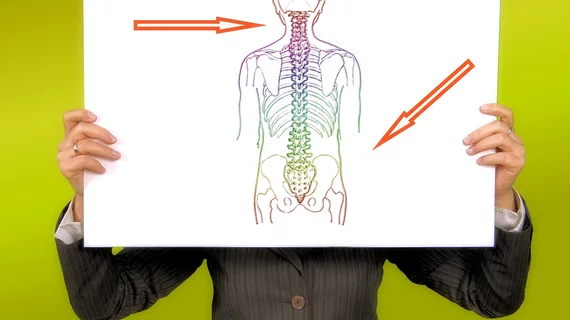Providing plain language and context in spine imaging reports helps drop opioid prescriptions
Using plain language in spine imaging reports can help decrease opioid prescriptions and may provide other intangible benefits.
That’s according to a new analysis from UW Medicine in Seattle, published recently in JAMA Network Open. Patients often visit their provider because of lower back pain, with imaging tests revealing no acute injury and only common signs of aging and deterioration. However, some will continue to pursue diagnoses until they receive the pain pills or other desired treatment.
UW imaging experts theorized that adding context in plain language to radiology reports would help decrease the use of healthcare resources. And the intervention appears to be paying off by lowering the number of opioid prescriptions at the institution.
“We thought this extra information would reassure the clinician and the patient that the finding is in the range of ‘normal’ for their age group, and lead to conservative treatment,” lead author, Jeffrey Jarvik, MD, a professor of radiology at the University of Washington School of Medicine, said in a Sept. 16 announcement. “The intervention in our study is inexpensive and simple to deploy, and thus could be used on a wide scale,” he added later.
To test their hypothesis, the team targeted nearly 239,000 patients as part of a randomized clinical trial conducted between 2013 and 2016. All received spine imaging at one of 98 primary care clinics across four large U.S. health systems. About half received the standard lumbar spine imaging report, while researchers gave the rest of the study population breakdowns that also discussed the prevalence of such findings in others of the same age.
Jarvik and colleagues had hoped the intervention would reduce healthcare utilization in the year following the first imaging exam, but that did not prove true. But they did produce a “small but significant” decrease in the likelihood of a primary care doc prescribing an opioid (odds ratio, 0.95; 95% confidence interval, 0.91 to 1.00; P = .04). It also reduced subsequent spine-related care—measured in relative value units—for a small portion of patients with CT as the initial imaging test.
“Reporting benchmark information is a fundamental change to the imaging reporting paradigm that may be relevant for other conditions and could easily be applied to other diagnostic tests (e.g., other imaging tests, genetic testing),” the research team concluded. “Finally, unmeasured benefits of the intervention may result from patients and healthcare professionals having a better understanding of the clinical meaning of imaging findings.”
Read more on their findings in JAMA Network Open here.

